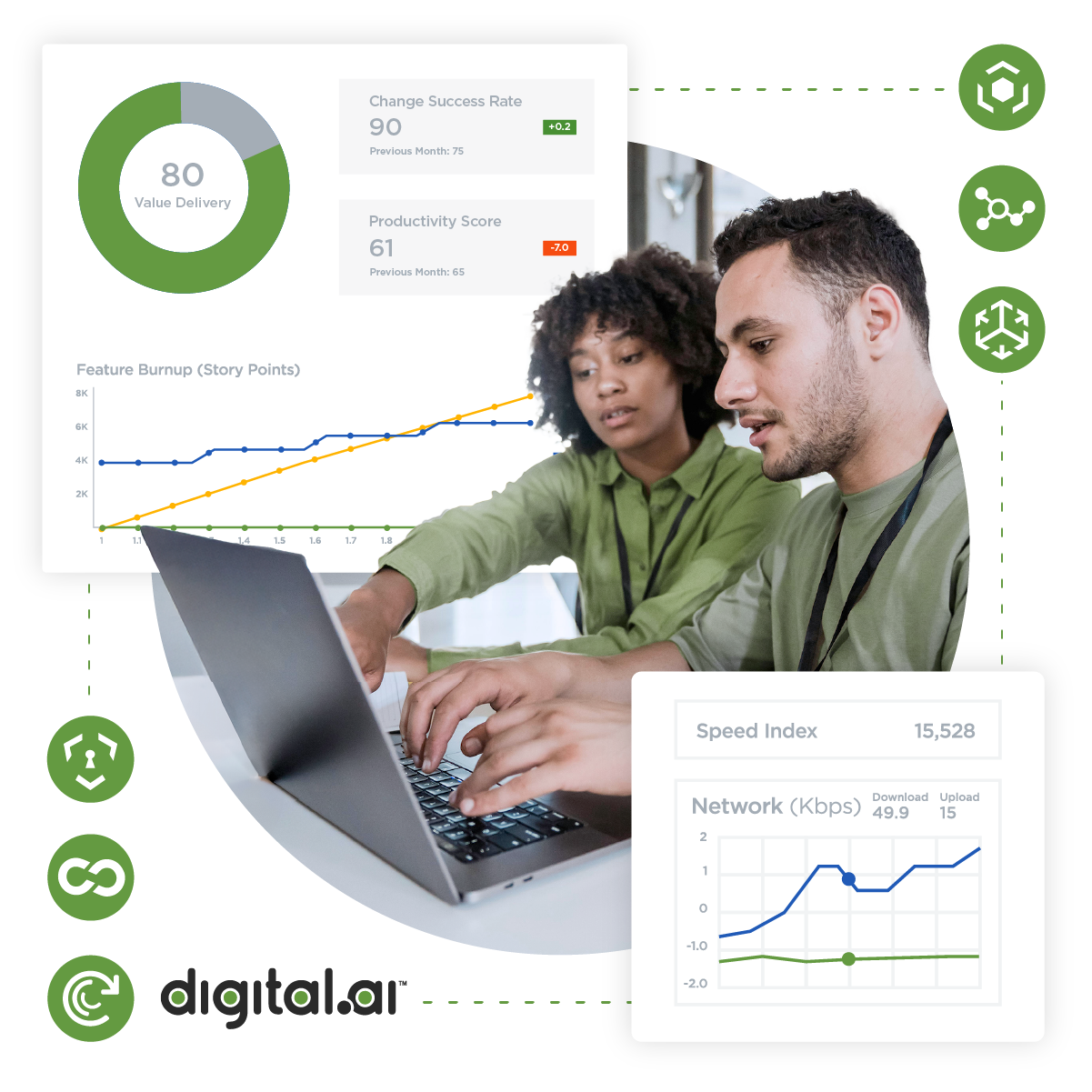Table of Contents
Related Blogs
If your organization is not seeing the results you expect from your digital transformation, consider taking a hard look at how analytics works across the company.
Nearly every major enterprise is already in the process of digital transformation, but some aren’t achieving the anticipated transformative results for their bottom line. As responses came in for Digital.ai’s Digital Transformation Progress Report survey, we discovered that 54% of respondents report their digital transformation has had a negative impact on their bottom line, and 49% report not seeing the results they expected.
There are many things that could be missing in an organization not seeing the success they set their sights on, but a lack of data availability and visibility can be the biggest one. Data monitoring allows organizations to directly see performance within their internal processes as well as the external outcomes of their work. Analytics can transform this data to produce profound insights, revealing weaknesses and bottlenecks while pointing to opportunities. Critically, data in digital transformation can also be used to uncover and quantify risks, allowing for effective risk management and rapid response. Overall, data signals guide organizations while helping them mark progress towards their most important priorities.
Despite the value data can produce, a Forrester report found that “firms make fewer than 50% of their decisions based on quantitative information as opposed to gut feeling, experience, or opinion.” The same report uncovered that 85% of respondents say they want to increase the amount of data insights available for decisions, yet 91% report major challenges with getting to this point.
Implementing a comprehensive data analytics system capable of automated importing of data from all key systems of record provides the solution these organizations need to make better progress towards their digital transformation goals.
Key benefits for data analytics include the ability to :
- Increase efficiency
- Accelerated agility
- Reduce riskaccelerUsing data analytics to increase efficiency
Many organizations can sense that their teams aren’t moving at the speeds they could be and that various factors weigh down their velocity. But often, IT leaders lack the data to quantify what KPIs are underperforming, let alone the data needed to reveal the most likely underlying causes.
With automated import from all key systems of record, an analytics platform like Digital.ai’s is capable of revealing insights needed to inform critical process changes.
Performance data across the end-to-end pipeline uncovers which teams (or vendors) are lagging. It can also reveal bottlenecks in the value delivery process. The poor performance reveals opportunities for new processes, technology, or coaching. Overall, monitoring performance KPIs allows organizations to hold teams more accountable using objective and transparent measures, giving them the tools they need to increase performance across the board.
Monitoring metrics like the sum of all unplanned work across all processes can give teams insights to eliminate sources of inefficiency and strive towards a less stressful DevOps environment. Operations data can be used to depict which IT issues have the biggest impact. Targeting the biggest pain points improves MTTR and can lead to more efficient incident resolution, minimizing downtime and other service impacts. For example, if a major source of generated tickets and delays is related to persistent database change requests, then operations can develop a streamlined process with permissions that better reflect team roles and automated approvals for select permission levels.
Leveraging data with machine learning (ML) and artificial intelligence (AI) can allow organizations to monitor critical sources of unplanned downtime and unplanned work. A root cause analysis engine, for instance, is capable of revealing the true drivers of incidents to eliminate them once and for all. As an example of this type of capability, a retailer client was having issues with its POS system across multiple regions; the Numerify (now Digital.ai Analytics) team helped the organization determine a singular cause, allowing their operations leaders to roll out a new knowledge base article instructing teams globally how to fix it.
Accelerating agility through data-driven insights
Agile transformation goals can often be aided through the use of proactive process optimizations and increased automation. Bottlenecks from team handoffs or transitions from one pipeline to the next are often a culprit, as are lengthy change approvals.
By leveraging analytics in digital transformation, organizations can align teams using a single view of priority KPIs. With this single source of truth, teams from end to end can focus on improvements to the value stream to reach specific outcomes, not just hit certain performance numbers. Customer-reported experience data can close the feedback loop for developers, for instance, allowing teams to see which releases didn’t just meet sprint velocity goals but also resulted in increased user satisfaction.
Data feedback such as this can be used to improve employee experience and collaboration across teams, overall. The use of data adds certainty, clarity, and accountability. When teams are given internal feedback they can know they aren’t becoming the victim of bias, and process change requests can be backed up by data demonstrating the expected results.
Providing a shared data source also allows teams to proactively monitor their own performance. They can even leverage self-service business intelligence from dashboards and analytics tools to analyze their own work outcomes and get answers to burning questions. As an example, a sprint planning team can sort changes by feature area then by escaped defects to show which feature areas tend to give the most trouble, informing them on which user stories in their portfolio would have the biggest positive impact on product experience.
Quantify and reduce risk with data-backed AI/ML technologies
AI/ML analytics engines can model drivers of change risks to identify practices or CIs that tend to generate the most vulnerabilities, issues, and incidents. Over time, historical data reveals the changes due for release that have the highest potential for causing a related incident. This contextual info can be used to drive automated CAB approvals for changes identified as low-level risks. For medium and high-level risks, the data gives context to manual reviews and allows the review to focus on specifically identified risk factors.
AI/ML-driven analytics engines allow organizations in the midst of a digital transformation to accurately document product performance for key metrics like escaped defects or unplanned service downtime. This information, in turn, informs targeted improvements to development and operations practices.
Understanding the drivers of change risk also allows organizations to rapidly identify and remediate SLA breaches, security threats, or situations where a change deployment leads to significant performance defects. Data on the drivers of change risk, therefore, closes the feedback loop on operations risks to inform agile feature planning, product portfolio management, and development practices as a whole.
Look to data analytics to reach your digital transformation goals
Lack of a single source of truth and continuous data feedback is one major weak spot in many organizations’ digital transformation initiatives. Without data, results can effectively be randomized. Or, worse, misguided intuition can drive the organization down the opposite path from progress.
With data analytics in digital transformation, the enterprise can take the temperature of progress across major initiatives and also glean insights necessary to improve the velocity of that progress. In this way, data-driven decision-making can become a part of the organization’s culture at all levels.
In the words of Gartner VP analyst Douglas Laney: “A company’s ability to compete in the emerging digital economy will require faster-paced, forward-looking decisions. Data and analytics leaders need to assert themselves into corporate strategic planning to ensure that data and analytics competencies are incorporated within the highest-level public-facing enterprise plans.”
The ability to see within processes and monitor performance end to end is key for getting a digital transformation initiative to fire on all cylinders. Many organizations can vaguely describe the pain points they feel during their digital transformation journey, but they can’t quantify it. Siloed reporting generated from individual applications, creating a fragmented view of individual systems, cannot make up for this lack of data visibility.
An organization-wide data analytics system like Digital.ai Analytics is needed. These systems are capable of importing data from the tools and platforms teams use every day, eliminating blind spots. It also aggregates the data to create universally applicable metrics that describe the sum outcome of specific value streams. Self-service query/sort drill-downn features and informative dashboards allow employee users at all levels to ask their own questions, obtain their own insights, and become proactive — self-driving each team towards targeted improvements.
Because of these capabilities, analytics can have a huge transformative impact, from the top of the organization down and then back to the top again. It may very well be the missing ingredient needed to make your recipe for digital transformation result in the outcome your organization has always envisioned.
Learn more about the transformative power of analytics in boosting your digital transformation progress in our recent webinar: “How to Achieve Resilient & High-Velocity IT Operations Through AI-powered Analytics“
Are you ready to scale your enterprise?
Explore
What's New In The World of Digital.ai
Better Together: Unlocking Endless Possibilities For Our Customers
This Valentine’s Day, join us in celebrating the unique stories that make our Digital.ai customers special!
Optimizing Cloud Adoption: Improving Visibility and Accelerating Release Velocity in Complex Environments
Discover how to optimize cloud adoption in complex environments by improving visibility, accelerating releases, and maintaining governance.
Guide: Developing a Cloud Migration Strategy
Transform your business with a strategic cloud migration. Learn about the benefits, challenges, and best practices to ensure a successful move to the cloud.




